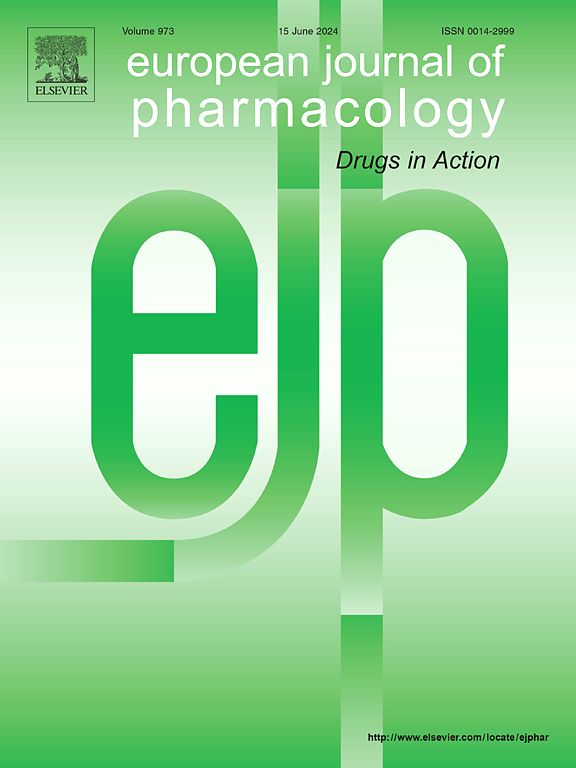The PPAR-α agonist oleoyethanolamide (OEA) ameliorates valproic acid-induced steatohepatitis in rats via suppressing Wnt3a/β-catenin and activating PGC-1α: Involvement of network pharmacology and molecular docking
IF 4.2
3区 医学
Q1 PHARMACOLOGY & PHARMACY
引用次数: 0
Abstract
Liver damage is one of the most severe side effects of valproic acid (VPA) therapy. Research indicates that PPAR-α prevents Wnt3a/β-catenin-induced PGC-1α dysregulation, which is linked to liver injury. Although PPAR-α activation has hepatoprotective effects, its role in preventing VPA-induced liver injury remains unclear. Our research used network analysis, molecular docking, and in-vivo validation to predict and assess targets and pathways associated with the hepatoprotective effects of oleoylethanolamide (OEA), a PPAR-α agonist, on VPA-induced steatohepatitis. For in-vivo experiments, 24 rats were assigned to V, OEA, VPA, and OEA + VPA. Liver functions, TGs, cholesterol, and LDL were tested. Hepatic levels of PPAR-α, ACO, TNF-α, IL-1β, HO-1, MDA, and TAC, along with Wnt3a/β-catenin, PGC-1α, and Nrf2 expression were assessed. Further, NF-κB, Bax, Bcl-2, and caspase-3 expression were detected immunohistochemically. Network pharmacology identified 258 targets for OEA-steatohepatitis connection, including NFKB1, PPARA, and NFE2L2, in addition to TNF, non-alcoholic fatty liver, NF-κB, PPAR, and WNT signaling, as contributing to steatohepatitis pathogenesis. The docking revealed a strong affinity between OEA and Wnt3a, β-catenin, and PGC-1α. Therefore, we postulated that the hepatoprotective effect of OEA may be due to Wnt3a/β-catenin-mediated inactivation of PGC1-α pathway. In vivo, OEA inhibited Wnt3a/β-catenin and increased PGC1-α by activating PPAR-α. Hence, PGC1-α reduced fat cell β-oxidation and NF-κB-mediated inflammation. OEA lessened MDA and raised TAC to mitigate oxidative damage. OEA additionally reduced apoptosis by lowering Bax/Bcl-2 ratio and caspase-3. In summary, PPAR-α involvement in the protective effects of OEA against VPA-induced steatohepatitis can be confirmed by suppressing Wnt3a/β-catenin and activating PGC-1α signaling.

PPAR-α激动剂油乙醇酰胺(OEA)通过抑制Wnt3a/β-catenin和激活PGC-1α改善丙戊酸诱导的大鼠脂肪性肝炎:参与网络药理学和分子对接。
肝损害是丙戊酸(VPA)治疗最严重的副作用之一。研究表明PPAR-α可阻止Wnt3a/β-catenin诱导的PGC-1α失调,而PGC-1α失调与肝损伤有关。尽管PPAR-α活化具有肝保护作用,但其在预防vpa诱导的肝损伤中的作用尚不清楚。我们的研究使用网络分析、分子对接和体内验证来预测和评估与油基乙醇酰胺(OEA)(一种PPAR-α激动剂)对vpa诱导的脂肪性肝炎的肝保护作用相关的靶点和途径。在体实验中,24只大鼠分为V、OEA、VPA和OEA+VPA。检测肝功能、tg、胆固醇和LDL。评估肝脏PPAR-α、ACO、TNF-α、IL-1β、HO-1、MDA、TAC水平,以及Wnt3a/β-catenin、PGC-1α、Nrf2表达。免疫组织化学检测NF-κB、Bax、Bcl-2和caspase-3的表达。网络药理学鉴定出258个oea与脂肪性肝炎相关的靶点,包括NFKB1、PPARA和NFE2L2,以及TNF、非酒精性脂肪肝、NF-κB、PPAR和WNT信号,这些靶点都与脂肪性肝炎的发病有关。对接发现OEA与Wnt3a、β-catenin和PGC-1α具有很强的亲和力。因此,我们推测OEA的保肝作用可能是由于Wnt3a/β-catenin介导的PGC1-α通路失活。在体内,OEA通过激活PPAR-α抑制Wnt3a/β-catenin,增加PGC1-α。因此,PGC1-α减少脂肪细胞β-氧化和NF-κ b介导的炎症。OEA降低MDA,提高TAC以减轻氧化损伤。OEA还通过降低Bax/Bcl-2比值和caspase-3来减少细胞凋亡。综上所述,PPAR-α参与了OEA对vpa诱导的脂肪性肝炎的保护作用,可以通过抑制Wnt3a/β-catenin和激活PGC-1α信号来证实。
本文章由计算机程序翻译,如有差异,请以英文原文为准。
求助全文
约1分钟内获得全文
求助全文
来源期刊
CiteScore
9.00
自引率
0.00%
发文量
572
审稿时长
34 days
期刊介绍:
The European Journal of Pharmacology publishes research papers covering all aspects of experimental pharmacology with focus on the mechanism of action of structurally identified compounds affecting biological systems.
The scope includes:
Behavioural pharmacology
Neuropharmacology and analgesia
Cardiovascular pharmacology
Pulmonary, gastrointestinal and urogenital pharmacology
Endocrine pharmacology
Immunopharmacology and inflammation
Molecular and cellular pharmacology
Regenerative pharmacology
Biologicals and biotherapeutics
Translational pharmacology
Nutriceutical pharmacology.

 求助内容:
求助内容: 应助结果提醒方式:
应助结果提醒方式:


